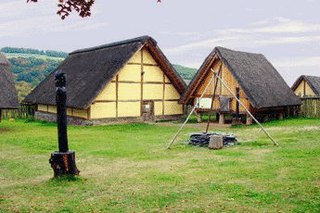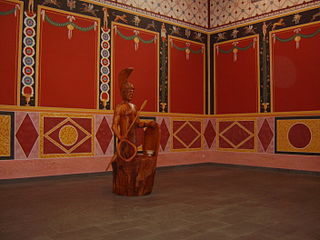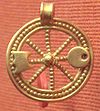
In ancient Celtic and Gallo-Roman religion, Cernunnos or Carnonos is a god depicted with antlers, seated cross-legged, and is associated with stags, horned serpents, dogs and bulls. He is usually shown holding or wearing a torc and sometimes holding a bag of coins and a cornucopia. He is believed to have originally been a Proto-Celtic God. There are more than fifty depictions and inscriptions referring to him, mainly in the north-eastern region of Gaul. Cernunnos is also associated with the Wiccan Horned God in the modern religious tradition of Wicca, via the discredited Witch-cult hypothesis.

In Gallo-Roman religion, Rosmerta was a goddess of fertility and abundance, her attributes being those of plenty such as the cornucopia. Rosmerta is attested by statues and by inscriptions. In Gaul she was often depicted with the Roman god Mercury as her consort, but is sometimes found independently.
Caturix was the war god of the Helvetii.
Alisanos was a local Gallo-Roman god worshipped in what is now the Côte-d'Or in Burgundy and at Aix-en-Provence.

In Gallo-Roman religion, Ancamna was a goddess worshipped particularly in the valley of the river Moselle. She was commemorated at Trier and Ripsdorf as the consort of Lenus Mars, and at Möhn as the consort of Mars Smertulitanus. At Trier, altars were set up in honour of Lenus Mars, Ancamna and the genii of various pagi of the Treveri, giving the impression of Lenus Mars and Ancamna as tribal protectors honoured in an officially organized cult. Among the few statuettes left as votive offerings at the sanctuary of Mars Smertulitanus and Ancamna at Möhn is one of a genius cucullatus like those offered to the Xulsigiae at the Lenus Mars temple complex in Trier.
In Gallo-Roman religion, Arduinna was the eponymous tutelary goddess of the Ardennes Forest and region, thought to be represented as a huntress riding a boar. Her cult originated in the Ardennes region of present-day Belgium, Luxembourg, and France. She was identified with the Roman goddess Diana.
Artio is a Celtic bear goddess. Evidence of her worship has notably been found at Bern in Switzerland. Her name is derived from the Gaulish word for 'bear', artos.
Belenus is an ancient Celtic healing god. The cult of Belenus stretched from the Italian Peninsula to the British Isles, with a main sanctuary located at Aquileia, on the Adriatic coast. Through interpretatio romana, Belenus was often identified with Apollo, although his cult seems to have preserved a certain degree of autonomy during the Roman period.
Belisama is a Celtic goddess. She was identified by Roman commentators with Minerva by interpretatio romana.

Grannus was a Celtic deity of classical antiquity. He was regularly identified with Apollo as Apollo Grannus and frequently worshipped in conjunction with Sirona, and sometimes with Mars and other deities.

In Celtic polytheism, Sirona was a goddess worshipped predominantly in East Central Gaul and along the Danubian limes. A healing deity, she was associated with healing springs; her attributes were snakes and eggs. She was sometimes depicted with Apollo Grannus or Apollo Borvo. She was particularly worshipped by the Treveri in the Moselle Valley.

In Gallo-Roman religion, Loucetios was a Gallic god known from the Rhine-Moselle region, where he was identified with the Roman Mars. Scholars have interpreted his name to mean ‘lightning’. Mars Loucetius was worshipped alongside the goddess Nemetona.

In ancient Celtic religion, Maponos or Maponus is a god of youth known mainly in northern Britain but also in Gaul. In Roman Britain, he was equated with Apollo.

In Celtic mythology, Nantosuelta is the goddess of nature, the earth, fire and fertility.

The Trēverī were a Celtic tribe of the Belgae group who inhabited the lower valley of the Moselle from around 150 BCE, if not earlier, until their displacement by the Franks. Their domain lay within the southern fringes of the Silva Arduenna, a part of the vast Silva Carbonaria, in what are now Luxembourg, southeastern Belgium and western Germany; its centre was the city of Trier, to which the Treveri give their name. Celtic in language, according to Tacitus they claimed Germanic descent. They possibly contained both Gallic and Germanic influences.
Icovellauna was a Celtic goddess worshiped in Gaul. Her places of worship included an octagonal temple at Le Sablon in Metz, originally built over a spring, from which five inscriptions dedicated to her have been recovered, and Trier, where Icovellauna was honored in an inscription in the Altbachtal temple complex. Both of these places lie in the valley of the river Moselle of eastern Gaul in what are now Lorraine in France and Rhineland-Palatinate in Germany. One such inscription was, somewhat unusually, inscribed on a copper tablet in Roman cursive letters.

Visucius was a Gallo-Roman god, usually identified with Mercury. He was worshipped primarily in the east of Gaul, around Trier and on the Rhine; his name is recorded on about ten dedicatory inscriptions. One such inscription has also been found in Bordeaux. Visucius is, along with Gebrinius and Cissonius, among the most common indigenous epithets of the Gaulish Mercury.

Lenus was a Celtic healing god worshipped mainly in eastern Gaul, where he was almost always identified with the Roman god Mars.

Ritona is a Celtic goddess chiefly venerated in the land of the Treveri in what is now Germany. Her cult is attested at Pachten and at Trier, where she "had a carefully built little temple" in the Altbachtal complex. Ritona's temple was one of several in the Altbachtal to include exedrae and courtyards that may have been used to prepare ritual banquets and/or to place offerings. At Pachten her temple also had a theatre, presumably used for performances of a religious nature.

Anvallus was a Gaulish god, known from several public inscriptions at Augustodunum (Autun). Two Latin inscriptions on altars were dedicated by gutuatres in requital of vows; both such dedications began with the formula Aug(usto) sacr(um). The title gutuater is typically understood to mean 'priest'; the gutuatres have at times been taken to be Romanized continuations of the druids. These altars were both discovered in 1900 on the site of Autun's railway station, along with a Greek-style helmet of thin bronze that would have been left there as a votive offering.















